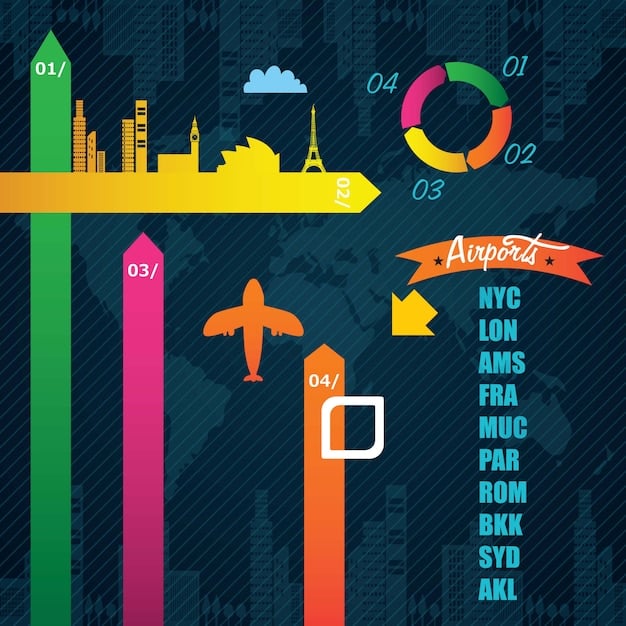CBAM Impact: Projecting Effects on US Exports to the EU

What Are the Projected Impacts of the New European Union Carbon Border Adjustment Mechanism (CBAM) on US Exports? The CBAM is expected to place a carbon price on specific goods imported into the EU from countries with less stringent climate policies, potentially increasing costs for US exporters and shifting trade patterns.
Understanding What Are the Projected Impacts of the New European Union Carbon Border Adjustment Mechanism (CBAM) on US Exports? is increasingly crucial for American businesses engaging with the European market. This mechanism is poised to reshape trade dynamics and environmental regulations, with significant implications for US companies.
Understanding the EU’s Carbon Border Adjustment Mechanism
The European Union’s Carbon Border Adjustment Mechanism (CBAM) is a landmark policy designed to address carbon leakage. It aims to ensure that imported goods are subject to a carbon price equivalent to that faced by domestic producers within the EU.
This mechanism is a cornerstone of the EU’s broader strategy to achieve its ambitious climate goals and promote sustainable practices globally.
What is Carbon Leakage?
Carbon leakage refers to the situation where businesses relocate their production to countries with less stringent environmental regulations to avoid carbon costs. CBAM aims to prevent this by leveling the playing field.
CBAM: How It Works
CBAM works by requiring importers of certain goods into the EU to purchase certificates corresponding to the carbon emissions embedded in the production of those goods. The price of these certificates will be linked to the EU Emissions Trading System (ETS), the EU’s carbon pricing system.

The ultimate goal is to incentivize cleaner production methods in countries exporting to the EU, as companies will need to demonstrate lower embedded emissions to reduce their CBAM liability.
In conclusion, the EU’s Carbon Border Adjustment Mechanism is designed so that it creates a more equal playing field for any company that exports into the EU, and encourages sustainable practices.
The Sectors Most Impacted by CBAM
CBAM will not affect all sectors equally. Some industries are more carbon-intensive than others, and these face the biggest potential impact from the new regulations. Understanding which sectors are most vulnerable is crucial for US exporters.
The initial phase of CBAM focuses on specific sectors known for their high carbon emissions. These sectors include:
- Cement
- Iron and Steel
- Aluminium
- Fertilizers
Assessing the Impact on Key US Export Sectors
For US exporters in these sectors, the introduction of CBAM will likely lead to increased costs. Companies will need to accurately measure and report emissions embedded in their products, and purchase CBAM certificates accordingly.
This added cost could affect the competitiveness of US exports in the EU market, particularly if production methods are less carbon-efficient compared to their European counterparts.
These sectors that are most impacted can expect a higher cost for exports, and in order to stay competitive, US exporters may want to consider a shift to green energy.
Projected Economic Impacts on US Exports
The economic implications of CBAM on US exports are multifaceted. While the exact magnitude of the impact remains uncertain, various studies and analyses offer insights into potential outcomes. The changes will include both direct costs from the CBAM certificate purchases, and indirect costs from any changes in trade patterns.
Several factors will determine the final economic impact, including the carbon intensity of US production methods, the price of CBAM certificates, and the responsiveness of US exporters to the new regulations.
- Increased Export Costs: US exporters will incur direct costs associated with purchasing CBAM certificates for goods entering the EU market.
- Trade Diversion: If US exporters find CBAM costs prohibitive, they may seek alternative markets outside the EU, leading to a shift in trade patterns.
- Incentives for Green Technology: The introduction of CBAM could incentivize US companies to invest in cleaner production technologies to reduce their carbon footprint. This could provide benefits beyond the EU market.
Overall, the economic impacts will be complex and vary depending on the specific industry and company. Mitigation strategies, such as investing in low-carbon technology or finding more lucrative markets, can help reduce the burden the cost will have.
Strategic Responses for US Businesses
Given the impending implementation of CBAM, US businesses need to proactively develop strategies to mitigate potential adverse effects and capitalize on new opportunities. Waiting until the last minute will not allow businesses to be well prepared.
There are multiple strategic options available to US companies, ranging from operational adjustments to long-term investments in sustainability.
Strategies for US Businesses
Some strategies would be to:
- Investments in Carbon Reduction Technologies – Implementing cleaner technologies.
- Carbon Footprint Assessment – Determine where the most emissions are coming from during production.
- Supply Chain Adjustments – Work with suppliers to reduce the full carbon footprint.
By taking proactive steps, US businesses can not only minimize the negative impacts of CBAM but also gain a competitive advantage in the global market.
The Geopolitical Implications of CBAM
Beyond the economic considerations, CBAM also carries significant geopolitical implications. It has the potential to reshape trade relationships, influence international climate negotiations, and affect diplomatic relations between the EU and its trading partners.
The US response to CBAM, in turn, could influence the future trajectory of transatlantic relations and the broader global climate agenda. There have been many debates about how the US will respond.
Potential Geopolitical Impacts
Here are some of the possible impacts:
- Trade Tensions: Differing views on climate policy could create trade tensions between the US and the EU
- International Climate Cooperation: CBAM could serve as a catalyst for broader international cooperation on climate change
- US Policy Response: How the US chooses to respond to CBAM will have major implications for transatlantic collaboration.
These factors will play a crucial role in shaping the geopolitical landscape surrounding CBAM and its impact on international relations.

Future Outlook and Potential Adaptations
The future of CBAM and its impact on US exports will depend on several factors, including the pace of its implementation, the evolution of international climate policy, and the adaptability of businesses to changing regulations. Considering this, it is still important to look further ahead.
The EU has already announced plans to gradually expand the scope of CBAM to include additional sectors and products. This means that US exporters should be prepared for a broader range of goods to be subject to CBAM requirements in the coming years.
In conclusion, it’s difficult to see to far into the future, but adaptation, and new tech will assist in keeping the cost of CBAM down.
| Key Element | Brief Description |
|---|---|
| 🏭 Impacted Sectors | Cement, iron, steel, aluminium, and fertilizers face initial CBAM charges. |
| 📈 Economic Effects | Increased export costs and trade pattern shifts for US businesses. |
| 🌱 Strategic Responses | Investing in green technologies for a sustainable, competitive edge. |
| 🌍 Geopolitical Shifts | Potential trade tensions if US disagrees about emissions policy. |
Frequently Asked Questions About CBAM
▼
The main goal is to prevent carbon leakage by ensuring that imports into the EU face a carbon price equivalent to what EU producers pay, fostering international climate efforts.
▼
Initially, the CBAM covers carbon-intensive sectors such as cement, iron and steel, aluminium, fertilizers, electricity and hydrogen.
▼
US exporters in covered sectors may face increased costs due to the need to purchase CBAM certificates, potentially impacting their competitiveness in the EU market. It will depend on the carbon cost, and size of their products.
▼
Businesses can invest in cleaner production technologies, accurately assess their carbon footprint, and engage with suppliers to reduce emissions across the supply chain.
▼
Yes, differing approaches to climate policy could strain trade relations; however, CBAM may also encourage cooperation and global carbon pricing agreements as countries seek to align climate policies.
Conclusion
What Are the Projected Impacts of the New European Union Carbon Border Adjustment Mechanism (CBAM) on US Exports? is not just a question but a call to action for US businesses. By understanding the implications, adapting strategies, and embracing sustainable practices, American companies can navigate the changing landscape and thrive in a low-carbon global economy. The actions include being ready for CBAM, utilizing strategic responses, and continuing to observe and adapt.





